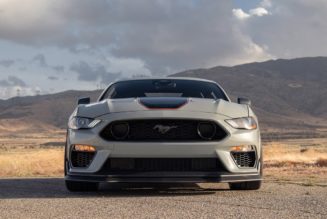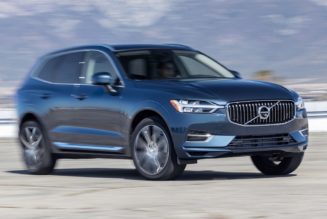Volkswagen Atlas Full Overview
Americans may be chomping at the bit for Ford Broncos, Jeep Wranglers, and Toyota 4Runners, but I’ve long had the theory that an all-wheel-drive crossover SUV on all-terrain tires could go 95 percent of the places that the average Wrangler or 4Runner (and eventual Bronco) owner goes off-road. I’m not talking about anything wild, like rock crawling in Moab or overlanding on the Mojave Road, but instead stuff like high-clearance 4×4 trails that dot national parks around the country, which are usually little more than a glorified forest road or hardpacked sand.
While a legion of Subaru owners (including my wife) have been proving me right for years by fitting their Outbacks, Foresters, and Crosstreks with all-terrain tires, VW thought it’d save its customers the trouble, offering up the 2021 Volkswagen Atlas Basecamp to buyers inclined to explore the great outdoors. Unfortunately, as I’d soon find out when exploring one of my favorite off-road parks, the Atlas Basecamp wildly misses the mark.
What Is the VW Atlas Basecamp?
The latest addition to the refreshed 2021 VW Atlas lineup, the Basecamp isn’t actually an official Atlas trim level—instead it’s an off-road-oriented accessories kit. The pieces were first revealed as a concept at the 2019 New York auto show. Although the concept sported meaty 265/70R17 BFGoodrich all-terrain tires, 17-inch Fifteen52 wheels, a 1.5-inch suspension lift, and a custom body kit, the version you can piece together from your local VW dealer is a little more low key.
Wearing the nipped and tucked body work of the refreshed 2021 Atlas, the production Atlas Basecamp gets some faux skidplates, 17-inch Fifteen52 wheels, and buyer’s choice of tires. The modest lift kit didn’t make it to the catalog. Whereas some similar (albeit smaller) off-road-oriented crossover SUVs, like the Toyota RAV4 TRD Off-Road, offer slightly retuned suspensions or unique off-road drive modes to go with the grippy off-road rubber, the Atlas Basecamp is otherwise identical to the rest of the lineup.
On some level that makes sense, because the Basecamp is broken into two packages available from your local Volkswagen dealer, not installed at the factory. The faux skidplates, silver rocker panels, and splash guards are part of a $2,498.99 (plus installation) Basecamp styling pack, and the custom Fifteen52 wheels, available in silver or black, are $250 each ($1,000 total). All-terrain tires notably aren’t part of the package, though VW says its dealers can recommend a set of off-road tires for customers. The 245/70R17 Continental TerrainContact A/Ts on our Atlas Basecamp are available at Tire Rack for $184.99 per tire ($739.96 before installation).
It’s worth noting that the Basecamp styling kit actually decreases the Atlas’ departure angle by 1 degree to 21.3 degrees. Approach and breakover angles remain unchanged at 20.4 and 17.5 degrees, respectively.
Basecamp accessories are available on all 2021 Atlas models equipped with tow hitches, except the R-Line as the styling package won’t fit. We suspect the wheel and tire packages would mount up to the 2021 Atlas R-Line (not to mention the 2021 Atlas Cross Sport) just fine.
Power comes courtesy of either a 235-hp 2.0-liter turbocharged I-4 or a 3.6-liter V-6 producing 276 hp and 266 lb-ft of torque. Both engines are paired with an eight-speed automatic transmission and either front- or all-wheel drive. Our tester was a well-equipped 2021 Atlas SEL V6 4Motion Basecamp equipped with the full line of Basecamp accessories. As tested, it stickered for $50,213.
How Does the Atlas Basecamp Drive?
Despite the off-road extras, the base Atlas package doesn’t seem to suffer on the road—if anything, the package actually improves its on-road driving experience in some important ways.
One of our biggest complaints about VW’s largest vehicle has been its poor ride quality. On the laundry list of complaints we had about the Atlas in our March 2020 three-row SUV Big Test (in which the Atlas finished dead last in a comparison of nine SUVs), its under-baked suspension tuning ranked at the top. “Then there’s [the Atlas’] ride,” we wrote. “Yekikian felt carsick after he finished the 50-minute loop and begged not to drive the Atlas home that night. Rechtin noted more head toss than in other SUVs.”
Riding on 17-inch wheels with fatter sidewalls versus the 20-inch wheels found on our last Atlas test car, ride quality has significantly improved with the Atlas Basecamp, becoming downright tolerable. Impact harshness and absorption on-road are pretty good, with the fatter Continental sidewalls doing a lot of the hard work the suspension can’t deal with.
The rest of the Atlas Basecamp driving experience feels identical to that of its more road-oriented brethren—and indeed our test numbers bear that out. Our V-6-equipped Atlas SEL 4Motion Basecamp accelerated from 0 to 60 mph in 7.8 seconds and through the quarter mile in 16.0 seconds at 88.6 mph, tying the last non-Basecamp 2020 Atlas SEL 4Motion we tested to 60 mph and trailing by a tenth of a second and a half mile per hour at the end of the quarter mile.
Despite the off-road tires, the Atlas Basecamp’s braking and handling results measure within spitting distance of the non-Basecamp model, too. Our 2021 Atlas Basecamp needed 123 feet to come to a stop in our 60-0 mph brake tests (versus 121 feet for a 2020 Atlas SEL), and it lapped the figure eight in 27.7 seconds at 0.61 g average, just a hair off the regular Atlas’ 27.1-second at 0.62 g performance.
So clearly, then, the Atlas Basecamp would seem to be an excellent way to have your cake and eat it, too. Except the package just doesn’t seem to work where it was intended—off-road.
How Is the Atlas Basecamp Off-Road?
Like I started out this review saying, many who buy hardcore off-road-oriented SUVs for the occasional foray onto a beach or forest trail would likely be better served by a crossover SUV on all-terrain tires. So I planned to take the Atlas Basecamp out on some trails I’m very familiar with at California’s Hungry Valley off-road park (an MT go-to for repeatable off-road testing). I was optimistic; my wife’s Crosstrek Hybrid on all-terrain tires made the very trails I had lined up for the Atlas look like a walk in the park.
I naively expected the same with the Atlas, even making the fatal mistake of leaving my recovery gear behind. The violent bounding back and forth off each axle as I piloted the Atlas Basecamp down a rutted dirt road at single-digit speeds should’ve been my warning sign. Both underdamped and oversprung at the same time, despite the extra tire sidewall, the Atlas quickly reminded me that its suspension wasn’t optimized for much more than glass-smooth pavement. In retrospect, I should’ve called it a day then, but I continued on into the park’s 4×4 practice area.
I decided to start with the “sand pit” course first. Little more than hardpacked sand and the occasional football-sized rock, it is quite literally the least challenging section of the entire park. Lining up before the entrance to the practice area were offset moguls about ankle high. I engaged Off-Road mode and motored over the first couple, the Atlas picking up a front and rear wheel on each one. It was slow but steady going until the last “hill,” when all of a sudden the front-left tire bit through the surface and started to spin.
And that was it. Despite having three other tires in contact with the ground, the Atlas was incapable of routing enough power to the other wheels. I tried every trick in the book to get the Atlas free—I reversed, turned off traction control, aired the tires down into the teens, rocked it back and forth, tried turning, wedged rocks, the Atlas’ floormats, and eventually both the floormats and rocks under the tires to get the VW moving again. Yet all I got for my troubles was an overheated transmission (outside temperatures were a cool 55 degrees at the time) as the Atlas dug itself in deeper.
Despite the off-road-oriented tires, the Atlas Basecamp just didn’t have the torque, advanced all-wheel-drive system, or stability control tuning to get it moving the 6 inches it needed to firmer terrain. After about an hour and a half of trying, I gave up and called the park rangers to yank me out. It took but a gentle tug by their Ram 1500 (and a lot of laughter) to free the Atlas and send me on my way.
So What Did We Learn?
Well, it turns out I was wrong—while a large portion of SUV buyers who do light off-roading may be well served by a crossover on all-terrain tires, not all crossovers and not all all-wheel-drive systems are created equal.
The Atlas, for instance, is little more than an upsized VW Passat, and although it does have all-wheel drive and this new Basecamp accessories package, it’s quite clear that VW engineers never intended for it to go through anything tougher than the occasional snow dusting. For the outdoorsy individual looking for a more capable three-row SUV, something like a Subaru Ascent, a rear-drive-based Dodge Durango, or Ford Explorer on all-terrain tires will likely serve you better with their more capable all-wheel-drive systems and off-road modes. If a factory-backed option like the Atlas Basecamp is a must, the new 2021 Jeep Grand Cherokee L, which will likely start around $40,000, ought to fit the bill, too.
As for the Atlas Basecamp—well, let’s just say next time one comes around the office, it isn’t leaving the pavement.
| 2021 Volkswagen Atlas SEL V6 4Motion Basecamp | |
| BASE PRICE | $49,473 |
| PRICE AS TESTED | $50,213 |
| VEHICLE LAYOUT | Front-engine, AWD, 7-pass, 4-door SUV |
| ENGINE | 3.6L/276-hp/266-lb-ft DOHC 24-valve V-6 |
| TRANSMISSION | 8-speed automatic |
| CURB WEIGHT (F/R DIST) | 4,659 lb (55/45%) |
| WHEELBASE | 117.3 in |
| LENGTH x WIDTH x HEIGHT | 200.7 x 78.4 x 70.1 in |
| 0-60 MPH | 7.8 sec |
| QUARTER MILE | 16.0 sec @ 88.6 mph |
| BRAKING, 60-0 MPH | 123 ft |
| LATERAL ACCELERATION | 0.81 g (avg) |
| MT FIGURE EIGHT | 27.7 sec @ 0.61 g (avg) |
| EPA CITY/HWY/COMB FUEL ECON | 16/22/18 mpg |
| ENERGY CONS, CITY/HWY | 211/153 kWh/100 miles |
| CO2 EMISSIONS, COMB | 1.06 lb/mile |








